Huawei Y5 Lite User Manual

User Guide
Contents
Foreword
Unboxing your Phone
Inserting a SIM card and microSD card |
2 |
Viewing the battery status |
2 |
Getting Started
Naming a SIM card |
3 |
Selecting the default mobile data SIM |
3 |
Setting the default SIM card |
3 |
Connecting to the Internet |
3 |
Screen and Display
Home screen |
5 |
Locking and unlocking the screen |
12 |
otific tion panel and status bar |
14 |
Navigation bar |
16 |
Themes |
17 |
Global search |
18 |
Screenshot |
19 |
Eye comfort mode |
20 |
Display settings |
21 |
Network and Sharing
Mobile Internet |
23 |
Wi-Fi |
25 |
Bluetooth |
26 |
VPNs |
27 |
Using a USB port to transfer data |
27 |
Security and Backup
File management |
29 |
Phone Manager |
29 |
Camera and Gallery
Camera options |
31 |
Photos and video recordings |
31 |
Viewing photos and videos |
33 |
Sharing photos and videos |
34 |
Editing a photo |
34 |
Editing Videos |
35 |
Calls and Contacts
i
|
Contents |
Making calls |
37 |
Answering calls |
38 |
Making a conference call |
40 |
In-call options |
40 |
Managing call logs |
42 |
Call settings |
42 |
Creating a contact card |
44 |
Creating a new contact |
44 |
Importing and exporting contacts |
44 |
Managing contacts |
45 |
Searching for contacts |
45 |
Adding a contact to your favorites |
46 |
Changing contact photos |
46 |
Viewing call records for individual contacts |
47 |
Messaging and Email
Sending a message |
48 |
Replying to a message |
48 |
Searching for messages |
48 |
Deleting message threads |
48 |
Managing messages |
49 |
onfiguring the message ringtone |
49 |
Adding an email account |
49 |
Sending emails |
50 |
Replying to emails |
50 |
Managing emails |
50 |
Searching emails |
51 |
Managing email accounts |
51 |
onfiguring Mail |
52 |
Calendar and Notepad
Changing the calendar view |
53 |
Creating an event |
53 |
Sharing events |
53 |
Deleting an event |
54 |
Searching for events |
54 |
Music and Video
Listening to music |
55 |
Searching for music |
55 |
Deleting songs |
55 |
Creating a playlist |
56 |
Playing a playlist |
56 |
Phone Manager
ii
|
Contents |
Enhancing speed |
57 |
Clock
Managing alarms |
58 |
onfiguring the world clock |
58 |
Stopwatch |
59 |
Timer |
59 |
Sound recorder
Recording sound |
60 |
System Features and Settings
Restarting your device |
61 |
Input method settings |
61 |
Editing text |
61 |
Airplane mode |
62 |
onfiguring the sound settings |
62 |
Setting up an account |
63 |
Viewing memory and storage information |
64 |
Setting the date and time |
64 |
Enabling location access |
64 |
Restoring factory settings |
65 |
OTA updates |
65 |
Viewing product information |
66 |
Accessibility features |
66 |
Obtaining help
Personal Information and Data Security
List of safety features
Legal Notice
iii

Foreword
Read this guide carefully before using your device.
All pictures and illustrations in this document are for your reference only and may differ from the fin l product.
Some features in this guide may not be supported by certain devices or carriers.
Symbols and definitions
Description
Highlights important information and tips, and provides additional information.
Reminder
Indicates potential problems that may arise if proper care or attention is not given, such as device damage or data loss.
Warning |
Warns you about potential hazards that could cause serious injury. |
|
|
1

Unboxing your Phone
Inserting a SIM card and microSD card
Your phone features a 3-in-1 SIM card slot. You can insert two nano-SIM cards and one microSD card. • The SIM card slot only supports nano-SIM cards. Contact your carrier for a new or replacement
nano-SIM card.
• Only use standard nano-SIM cards to avoid damaging the SIM card tray.
• Ensure that the card is in the correct position and keep the card tray level when inserting it into your device.
• Be careful not to hurt yourself or damage your device when using the SIM eject pin.
• Store the SIM eject pin out of the reach of children to prevent accidental swallowing or injury. • The SIM eject pin should only be used to eject the SIM card tray. Inserting the SIM eject pin into
other holes may damage your device.
1 Touch and hold the power button and touch  to turn off your device.
to turn off your device.
2To remove the card tray, insert the SIM eject pin included with your device into the small hole next to the card tray.
3 Insert a SIM card or microSD card into the card tray.
4 Insert the card tray back into your phone in the correct orientation.
Viewing the battery status
You can view the battery status and configure the status bar to display the remaining battery percentage.
Displaying the remaining battery percentage in the status bar
• Open  Settings. Touch Battery > Battery percentage.
Settings. Touch Battery > Battery percentage.
2

Getting Started
Naming a SIM card
By default, each SIM card is named after the carrier. You can rename your SIM card to make it easier to identify.
 • This feature is only available on dual SIM phones. • Features may vary depending on your carrier.
• This feature is only available on dual SIM phones. • Features may vary depending on your carrier.
1
2
3
Open  Settings.
Settings.
Touch Network & Internet > SIM cards.
Select a SIM card name. Enter a name and touch OK.
Selecting the default mobile data SIM
You can select a default SIM card for mobile data services.  • This feature is only available on dual SIM phones. • Features may vary depending on your carrier.
• This feature is only available on dual SIM phones. • Features may vary depending on your carrier.
1 Open  Settings.
Settings.
2 Touch Network & Internet > SIM cards.
3 Toggle the switch Mobile data next to the selected SIM card.
Setting the default SIM card
You can select a default SIM card for outgoing calls.  This feature is only available on dual SIM phones.
This feature is only available on dual SIM phones.
1
2
3
Open  Settings.
Settings.
Touch Network & Internet > SIM cards. Touch Calls and select your desired SIM card.
Connecting to the Internet
Connect to Wi-Fi networks effortlessly with your device.
Connecting to a Wi-Fi network
1 |
Swipe down from the status bar to open the notific tion panel. |
|
2 |
Touch and hold |
to open the Wi-Fi settings screen. |
3 |
Switch on Wi-Fi. Your device will list all available Wi-Fi networks at your location. |
|
3

Getting Started
4Select the Wi-Fi network you want to connect to. If you select an encrypted network, you will also need to enter the Wi-Fi password.
Connecting using mobile data
 Before using mobile data, ensure that you have a data plan with your carrier to avoid incurring excessive data charges.
Before using mobile data, ensure that you have a data plan with your carrier to avoid incurring excessive data charges.
1 Swipe down from the status bar to open the notific tion panel.
2 Touch  to enable mobile data.
to enable mobile data.
 Disable mobile data when not required so as to save battery power and reduce data usage.
Disable mobile data when not required so as to save battery power and reduce data usage.
4

Screen and Display
Home screen
About the home screen
Use the home screen to access your apps and widgets.
 Status bar:
Status bar:
Displays notifications and status icons
Display area:
Displays app icons, folders, and widgets
 Dock bar: Displays frequently used apps
Dock bar: Displays frequently used apps
Basic screen gestures
Use simple touchscreen gestures to perform a variety of tasks, such as launch apps, scroll through lists, and enlarge images.
Touch: Touch an item once. For example, touch to select an option or open an app.
Double touch: Touch the target area of the screen twice in quick succession.
5

Screen and Display
Touch and hold: Touch and hold the target area of the screen for at least 2 seconds. For example, touch and hold a blank area on the home screen to access the home screen editor.
Swipe: Swipe your fingers on the screen. Swipe vertically or horizontally to browse other home screens, scroll through a document, and more.
Drag: Touch and hold an item, and then move it to another position. For example, use this gesture to rearrange apps and widgets on the home screen.
Spread fingers apart: Spread two fingers apart on the screen. For example, spread two fingers apart to zoom in on a picture or web page.
Pinch fingers together: Pinch two fingers together on the screen. For example, pinch two fingers together to zoom out on an image.
Enabling the Drawer home screen
Use the Drawer home screen to store app icons in a separate app drawer.
Enabling the Drawer home screen
1
2
Open  Settings.
Settings.
Touch Home screen style > Drawer.
Adding app shortcuts to the home screen
Add frequently used apps to the home screen for quick access.
1 On the home screen, touch  to view the list of apps.
to view the list of apps.
2Touch and hold an app icon until your device vibrates, and then drag the app icon to the desired location on the home screen.
6
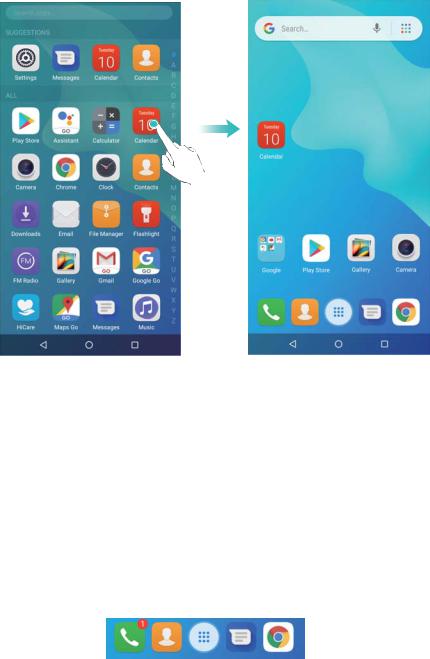
Screen and Display
 You must have enough space on the home screen. If there is not enough space, add another home screen or free up some space.
You must have enough space on the home screen. If there is not enough space, add another home screen or free up some space.
Reverting to the standard home screen
1
2
Open  Settings.
Settings.
Touch Home screen style > Standard.
Displaying or hiding notific tion badges
otific tion badges appear in the top-right corner of app icons. The badge number indicates the number of new notific tions Open the corresponding app to view notific tion details.
1
2
3
On the home screen, pinch two fingers together to open the home screen editor. Touch Settings > Badge app icons.
Toggle the corresponding switch to enable or disable notific tion badges.
Setting the home screen wallpaper
Choose from a wide range of themes and wallpapers to personalize your device.
Changing the wallpaper
1
2
Open  Settings.
Settings.
Touch Display > Advanced > Wallpaper > Wallpapers > Set wallpaper.
7

Screen and Display
3Select the desired wallpaper and follow the onscreen instructions to set it as the home screen or lock screen wallpaper (or both).
Managing home screen icons
You can easily move or uninstall apps on the home screen.
Moving home screen icons
On the home screen, touch and hold an app icon or widget until your device vibrates. You can then drag the app icon or widget to the desired location.
Uninstalling apps from the home screen
If your phone home screen style is standard, on the home screen, touch and hold the app or widget
you want to uninstall until  is displayed at the top of the screen. Drag the unwanted app or widget
is displayed at the top of the screen. Drag the unwanted app or widget
to  , and follow the onscreen instructions.
, and follow the onscreen instructions.
8
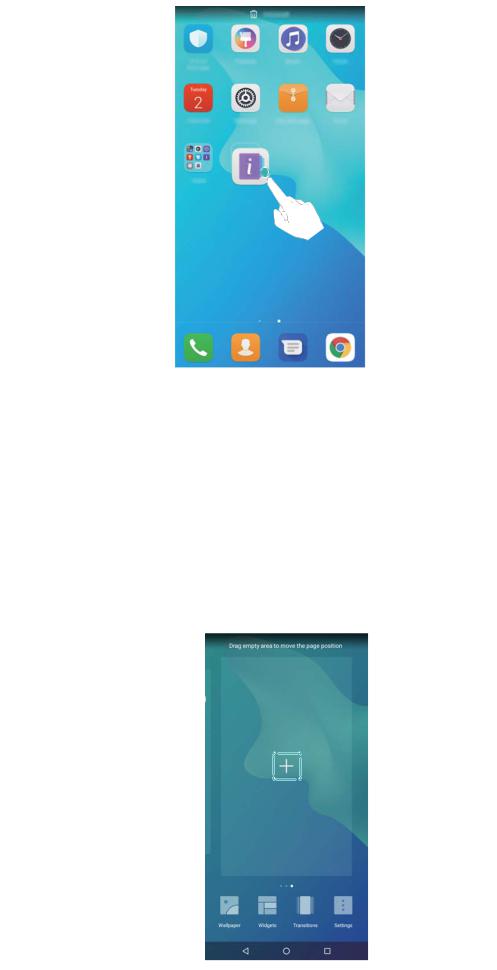
Screen and Display
 Some pre-installed apps cannot be uninstalled for the proper running of the system.
Some pre-installed apps cannot be uninstalled for the proper running of the system.
Managing home screens
You can customize home screens to your liking.
Adding home screens
1 On the home screen, pinch two fingers together to open the home screen editor.
2 Touch  on the home screen furthest to the left or right to add a new screen.
on the home screen furthest to the left or right to add a new screen.
9
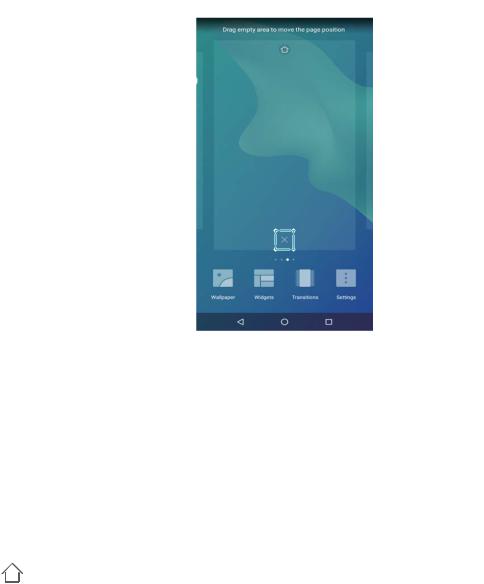
Screen and Display
Deleting home screens
1 On the home screen, pinch two fingers together to open the home screen editor.
2 Touch  on a blank screen to delete it.
on a blank screen to delete it.
 You cannot delete a home screen if it contains apps or widgets.
You cannot delete a home screen if it contains apps or widgets.
Moving home screens
1 On the home screen, pinch two fingers together to open the home screen editor.
2 Touch and hold the home screen you want to move and drag it to the desired location.
Setting the default home screen
1 On the home screen, pinch two fingers together to open the home screen editor.
2 Touch |
at the top of a home screen to set the chosen home screen as default. |
Managing home screen widgets
Add, move, or delete widgets from the home screen.
Adding widgets
1 On the home screen, pinch two fingers together to open the home screen editor. 2 Touch Widgets. Select a widget and drag it to a blank area on the home screen.
10

Screen and Display
Moving widgets
On the home screen, touch and hold a widget until your device vibrates, and then drag the widget to the desired location.
Deleting widgets
On the home screen, touch and hold a widget until your device vibrates, and then drag the widget to Remove at the top of the screen.
Managing home screen folders
Organize your apps into folders so that you can find them more easily.
Creating a folder
Group your apps into categorized folders to make them easier to find For example, you could create a Social folder for your social media apps.
On the home screen, drag an icon onto another icon to create a folder containing both apps.
11
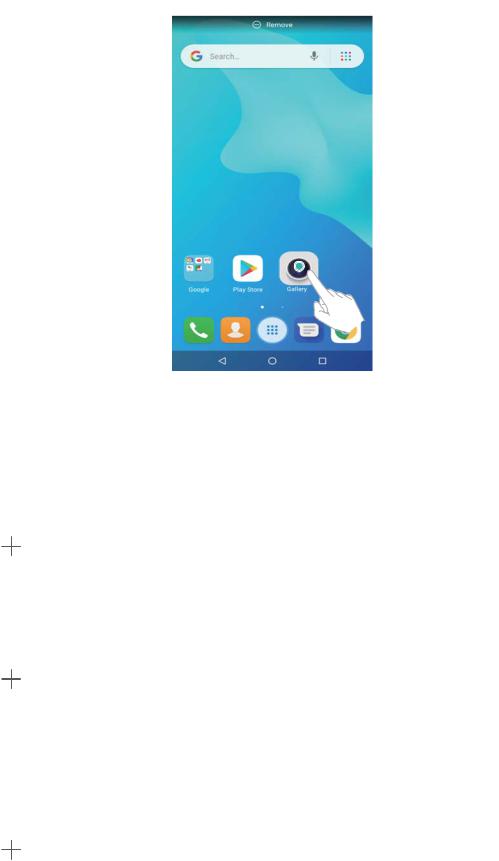
Screen and Display
Renaming folders
To rename a folder, open it and touch the folder name.
Adding apps to a folder
1 Open the folder.
2 |
Touch |
. |
3 |
Select the apps you want to add and touch OK. |
|
Removing apps from a folder
1 Open the folder.
2 |
Touch |
. |
3 |
Deselect the apps you want to remove and touch OK. |
|
 You can also touch and hold an icon and drag it outside a folder to remove it.
You can also touch and hold an icon and drag it outside a folder to remove it.
Deleting folders
1 Open the folder.
2 |
Touch |
. |
3 |
Deselect all of the apps and touch OK. The folder will be deleted automatically. |
|
Locking and unlocking the screen
Changing the lock screen style
Set a screen lock password to prevent unauthorized access to your device.
12
Screen and Display
Setting the screen lock password
1
2
Open  Settings.
Settings.
Touch Security & location > Screen lock > Password
3You can choose to unlock the screen with an unlock pattern, PIN, or password:
• Touch Pattern and connect at least four dots twice to create a screen unlock pattern.
• Touch PIN. Follow the onscreen instructions to create a PIN containing at least four digits, and then touch OK.
• Touch Password. Follow the onscreen instructions to create a password containing at least four characters, and then touch OK.
Locking the screen
Lock the screen to reduce power consumption and prevent unintended presses or unauthorized access to your data.
• Manual lock: Press the Power button to manually lock the screen.
• Automatic lock: The screen will lock automatically and enter sleep mode after the preset sleep time to reduce power consumption and prevent unintended operations.
 To change the screen sleep time, touch
To change the screen sleep time, touch  Settings > Display > Advanced > Sleep and select a time.
Settings > Display > Advanced > Sleep and select a time.
Unlocking the screen
1 Press the Power button to turn on the screen. 2 Swipe on the screen in any direction.
 • If you have set a screen unlock pattern, PIN, or password, you will need to draw the unlock pattern or enter your PIN/password to unlock the screen.
• If you have set a screen unlock pattern, PIN, or password, you will need to draw the unlock pattern or enter your PIN/password to unlock the screen.
Accessing tools from the lock screen
Launch apps directly from the lock screen.
1 Swipe up from the bottom of the lock screen to display lock screen features and tools.
13

Screen and Display
 Swipe up on the camera icon on the lock screen to directly open the camera.
Swipe up on the camera icon on the lock screen to directly open the camera.
onfiguring your lock screen signature
onfigure a lock screen signature to personalize your lock screen.
1
2
3
Open  Settings.
Settings.
Touch Security & location >  > Lock screen message. Enter your lock screen signature and touch SAVE.
> Lock screen message. Enter your lock screen signature and touch SAVE.
Your lock screen signature will be displayed on the lock screen.
otific tion panel and status bar
About the status bar
Use the status bar to access the notific tion panel and check your device's status.
Opening the notific tion panel and status bar
Opening the notific tion panel and status bar from the lock screen
Turn on the screen and swipe down from the status bar to open the notific tion panel. Then you can switch on or off shortcut switches, or view notific tion messages.
Opening the notific tion panel and status bar when the screen is unlocked
Swipe down from the status bar to open the notific tion panel. Then you can switch on or off shortcut switches, or view notific tion messages.
14
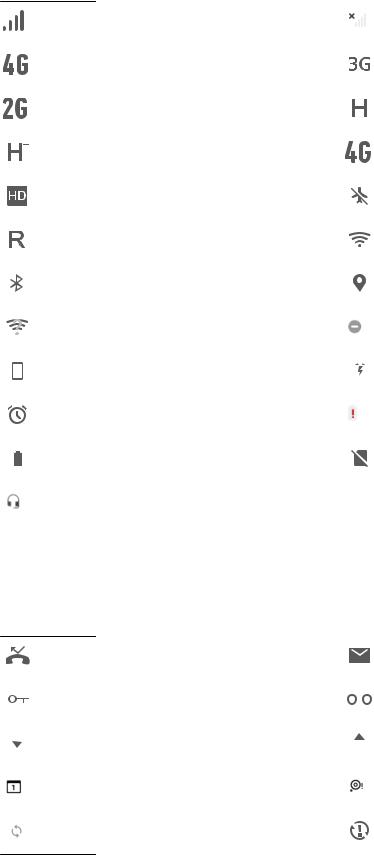
Screen and Display
About notific tion and status icons
Status icons
Status icons are displayed on the right-hand side of the notific tion bar and tell you about your device's status, including network connections, signal strength, battery, and time.
 Status icons may vary according to your region or carrier.
Status icons may vary according to your region or carrier.
|
|
|
|
|
Signal strength |
|
|
No signal |
|
|
|
|
|
|
|
|
|
|
|
|
|
|
Connected over 4G |
|
|
Connected over 3G |
|
|
|
|
|
|
|
|
|
|
|
|
|
|
Connected over 2G |
|
|
Connected over HSPA |
|
|
|
|
|
|
|
|
|
|
|
|
|
|
Connected over HSPA+ |
|
|
Connected over LTE |
|
|
|
|
|
|
|
|
|
|
|
|
|
|
VoLTE enabled |
|
|
Airplane mode enabled |
|
|
|
|
|
|
|
|
|
|
|
|
|
|
Roaming |
|
|
Connected over Wi-Fi |
|
|
|
|
|
|
|
|
|
|
|
|
|
|
Bluetooth enabled |
|
|
Receiving location data from GPS |
|
|
|
|
|
|
|
|
|
|
|
|
|
|
Wi-Fi network available |
|
|
Silent mode enabled |
|
|
|
|
|
|
|
|
|
|
|
|
|
|
Vibration mode enabled |
|
|
Charging |
|
|
|||||||
|
|
|
|
|
||||
|
|
|
|
|||||
|
|
|
|
|
|
|
|
|
|
|
|
|
|
Alarm enabled |
|
|
Battery low |
|
|
|
|
|
|
|
|
|
|
|
|
|
|
Battery full |
|
|
No SIM card found |
|
|
|
|
|
|
|
|
|
|
|
|
|
|
Headset inserted |
|
|
|
|
|
|
|
|
|
|
|
|
otific tion icons
otific tion icons are displayed on the left-hand side of the status bar when you receive a new message, notific tion or reminder.
|
|
|
Missed calls |
|
|
|
|
New emails |
|
|
|
|
|
|
|
|
|
|
|
|
Connected to a VPN |
|
|
|
|
New voicemail |
|
|
|
|
|
|
|||
|
|
|
|
|
|
|
|
|
|
|
|
Downloading data |
|
|
|
|
Uploading data |
|
|
|
|
|
|
|
||
|
|
|
|
|
|
|
||
|
|
|
|
|
|
|
||
|
|
|
|
|
|
|
|
|
|
|
|
Upcoming events |
|
|
|
|
Device memory full |
|
|
|
|
|
|
|
|
|
|
|
|
Synchronizing data |
|
|
|
|
Synchronization failed |
15
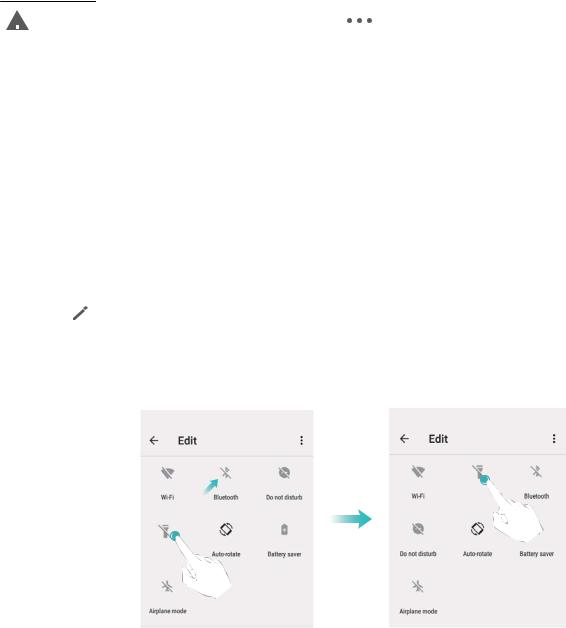
Screen and Display
|
|
Login or synchronization issue |
More notific tions |
|
|
||
|
|
||
|
|
|
|
Using shortcut switches to access settings
Use shortcut switches to quickly enable or disable frequently-used features.
Accessing shortcut switches
Swipe down from the status bar to open the notific tion panel.
 Touch
Touch  to display all of the shortcut switches.
to display all of the shortcut switches.
onfiguring shortcut switches
1 |
Swipe down from the status bar to open the notific tion panel. |
|
2 |
Touch |
. Touch and hold a switch and drag it to the desired position. |
3Touch a switch to enable the corresponding feature. If the switch supports touch and hold gestures, touch and hold the switch to access the settings for the corresponding feature.
 Some switches do not support touch and hold gestures.
Some switches do not support touch and hold gestures.
Navigation bar
About the navigation bar
The navigation bar contains three virtual keys: Back, Home, and Recent.
•  Back: Touch to return to the previous screen or close an app. When entering text, touch to close the onscreen keyboard.
Back: Touch to return to the previous screen or close an app. When entering text, touch to close the onscreen keyboard.
• Home: Touch to return to the home screen.
Home: Touch to return to the home screen.
• Recent: Touch to display recently used apps.
Recent: Touch to display recently used apps.
16

Screen and Display
Managing recent tasks
Viewing recent tasks
Touch  Recent to display recent tasks. Swipe up and down to browse them.
Recent to display recent tasks. Swipe up and down to browse them.
Switching between recent tasks |
|
||
1 |
Touch |
Recent. |
|
2 |
Swipe up or down to find the task you want to switch to and select it. |
||
Ending recent tasks |
|
||
1 |
Touch |
Recent. |
|
2 |
To end a task, swipe it to the left or right or touch the |
icon in the top-right corner. |
|
 • Touch CLEAR ALL to end all tasks.
• Touch CLEAR ALL to end all tasks.
Themes
About themes
Themes help you to personalize your home screen by changing the wallpaper, app icons, and more.
Changing the theme
1
2
Open  Themes.
Themes.
You can:
17

Screen and Display
• Select a theme and follow the onscreen instructions to configure the settings.
• Touch Customize to mix and match lock screen methods, wallpapers, app icons, and more.
Global search
About global search
Use global search to find apps, contacts and messages on your device.
Swipe down on the home screen to open the global search window, and then enter your search terms.
Searching for content on your device
Searching for contacts
1 Swipe down on the home screen to display the search bar.
2Touch the search bar and enter the contact name, initials, phone number, email address, or other information. Matching results will be displayed underneath.
 To improve the accuracy of search results, enter more than one keyword. Each keyword should be separated by a space (for example "John Smith New York").
To improve the accuracy of search results, enter more than one keyword. Each keyword should be separated by a space (for example "John Smith New York").
Searching for emails
1 Swipe down on the home screen to display the search bar.
2Enter one or more keywords (such as the email subject). The results will be displayed underneath the search bar.
18

Screen and Display
Searching for apps
1
2
Swipe down on the home screen to display the search bar.
Enter one or more keywords. The results will be displayed underneath the search bar.
 When using the Drawer home screen layout, you can also search for apps by touching
When using the Drawer home screen layout, you can also search for apps by touching  and entering the app name in the search bar.
and entering the app name in the search bar.
Screenshot
Capturing the entire screen
Taking a screenshot with the power and volume down buttons
Press the Power button and Volume down button to take a full screenshot.
Viewing, editing, deleting, and sharing screenshots
Viewing screenshots
1
2
Open  Gallery.
Gallery.
On the Albums tab, touch Screenshot to view your screenshots.
Editing a screenshot |
|
|
1 |
After taking a screenshot, touch |
. |
2 |
Choose the desired options to edit the image. |
|
3 |
Touch SAVE to save the changes. |
|
19

Screen and Display
Sharing a screenshot
1
2
3
4
Open  Gallery.
Gallery.
On the Albums tab, touch Screenshot.
Select the screenshot you want to share and touch  .
.
Choose how you want to share the screenshot and follow the onscreen instructions.
Deleting a screenshot
1
2
3
Open  Gallery.
Gallery.
On the Albums tab, touch Screenshot.
Select the screenshot you want to delete and touch |
> Delete. |
Eye comfort mode
Eye comfort mode decreases the amount of blue light emitted from the screen to reduce eye strain.
Eye comfort mode
1
2
Open  Settings.
Settings.
Touch Display > Eye comfort and switch on Eye comfort.
Adjusting the color temperature
Eye comfort mode reduces the amount of blue light emitted from the screen, which may give the screen a slightly yellow hue. You can adjust the color temperature to control the amount of blue light.
20
